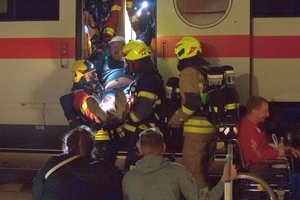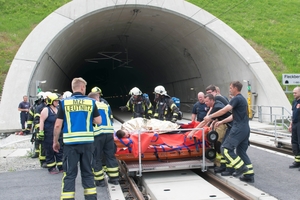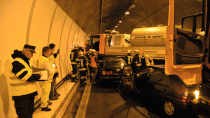Largest Rescue Exercise in Germany with the Involvement of STUVA: ICE Fire in the Fleckberg Tunnel
More than 1000 ambulance and fire service personnel, 300 actors and more than 200 referees, observers and guests: the exercise in the Fleckberg rail tunnel in Thuringia, which took place on 22 June 2019, was the largest of its type so far in Germany and probably the most realistic. The exercise scenario: an ICE train with 300 passengers came to a standstill in the middle of the tunnel after an emergency braking manoeuvre. The occurrence of a fire in the transformers makes further progress impossible and develops into a full fire. There is smoke everywhere and the screams of the injured echo through the tunnel. There are deaths and injuries – heavy physical work and great stress for all emergency services!
The STUVA was also involved in the preparation and implementation of the exercise. They are currently working with other partners under the lead of the German association for rail transport research of the federal railway office (DZSF of the EBA) on the research project SIKET (Evaluation and further development of the safety concepts for rail tunnels). This is supported under the program “Research for civil safety” of the Federal Ministry for Education and research (BMBF). The STUVA is responsible within SIKET for the modelling of smoke propagation and the further development of a holistic safety and rescue concept. For the exercise in the Fleckberg Tunnel, they looked after the smoke propagation and are involved in the assessment of the extensive results.
Simulation of the entire Rescue Chain
In order to keep the simulation as realistic as possible, the German Red Cross (DRK) state association for Thuringia together with the SIKET research project assigned individual injury descriptions for about 60 “serious and very serious” injured. As in real life, the vital values improved after medical treatment, but could also worsen without treatment. Employees of the Centre for Security and Society at the Chair for Sociology of the Albert-Ludwigs-University, Freiburg, had created a personal identity and travel history (starting point and destination of the journey, reason etc.) for each of the “passengers”. Social groups (family, clubs, friends etc.) were also formed in advance and remained together after the incident, got lost and searched but also supported each other. All these features were planned in advance as realistically as possible. The Thuringian state police had even created the appropriate passes for the individual passengers according to the previously decided keys. The exercise was not only restricted to the tunnel with the altogether three rescue areas at the tunnel portals and at the emergency exit. Since the rescue chain was to be completely represented, nine hospitals were also involved in the exercise. These took the opportunity to practice the treatment of a mass of injured people in all their departments (A&E, diagnostic, operating theatres and intensive care wards). A rescue helicopter of the ADAC carried the patients by air to the assigned hospitals. The state and federal police were also involved with several helicopters and more than 100 police.
Scientific Support from SIKET
With personal stories and injury patterns for each passenger laid down in advance, the SIKET employees succeeded in providing the most realistic possible effect on the emergency services. During the exercise, the scientists then filled the tunnel with smoke, heavily in places, using powerful smoke machines, which further considerably improved the realistic nature of the situation for the rescue services. Naturally the simultaneous assumption of the scenarios “fire”, “emergency stop”, “stop in the tunnel” as well as the number of injuries in this combination was anything but realistic and actually made the exercise undesirably artificial. This was however accepted in order to be able to test many aspects of the rescue chain and also the effectiveness of the safety equipment in the tunnel.
In the next step, the great quantity of recorded data (videos, photos, observations and interviews with the various parties involved) will be assessed by SIKET and used in further work in the research project. The objective is to use the data gained to extend the currently available tools for rescue from rail tunnels. In the future, it is planned to use the gathered impressions to create an exercise environment in virtual reality (VR) to permit fire service personnel to practice such special situations without laborious tunnel closures. Finally the key objective of SIKET is to prepare emergency services and railway personnel for incidents or, better still, to avoid such incidents happening at all. You can find further information about SIKET under //www.sifo.de" target="_blank" >www.sifo.de:www.sifo.de.
Fleckberg Tunnel: difficult Topography for Rescue Missions
The 1490 m long Fleckberg Tunnel in the Thuringian Forest is part of the 107 km long new line from Ebensfeld to Erfurt on the European high-speed route from Italy to Scandinavia. In this challenging topographical location, 109 engineering structures in a distance of 30 km – including 22 tunnels – are situated one after another. The VDE 8.1 project is the largest and most complex single project of the German unity transport project No. 8 and thus represents a great challenge for the emergency services from Thuringia and Bavaria. The objective was therefore set at an early stage to develop a cross-border rescue concept for all 22 tunnels.
The probability that a burning train actually stops in the tunnel is incidentally extremely small. The DB AG (German Railways) has taken numerous measures in their vehicles to prevent the occurrence of fire. In case a fire does however break out, the requirement is that the train does not strop inside the tunnel. Therefore trains are fitted, for example, with an emergency brake override in order to enable continued travel out of the tunnel where the conditions for evacuation and fire extinguishing are much better.
Detect, Extinguish, Search and Rescue
The coordination staff of “Hazard management on VDE 8.1” has already been working since 2011 on the development and refinement of a rescue concept. This coordination management team is composed of all units responsible for preventing and dealing with hazards in the concerned districts in Thuringia, Bavaria and the City of Erfurt. The Thuringian state fire service and civil defence school is also involved, as are representatives of the DB Netz AG, the state and federal police, the psychosocial emergency staff, the THW technical assistance organisation and other aid organisations.
The rescue deployment plan is based above all on so-called tunnel base units (TBE). A TBE describes a firmly associated troop of several fire service vehicles and their crews. For the section of VDE 8.1, the Thuringian districts and the City of Erfurt provide altogether 18 TBE and Bavaria 9 TBE. The tactical procedure is divided, depending on the nature of the incident, into the three phases “detect”, “extinguish”, and “search and rescue”. The relevant individual tasks are assigned to certain fire engines of the predefined TBE.
Whoever Arrives First, also Acts First
One particular aspect of the rescue plan for VDE 8.1 is that each crew of the altogether 54 vehicles is formed and equipped so that they can carry out any of the three tasks. This makes all units universally deployable. All TBEs are planned for deployment in several tunnels but arrive at the incident location at different times due to the different distances. So for example the crew of a fire engine arriving at a nearby tunnel forms the detection troop and a fire engine arriving from further away becomes part of the search and rescue troop.
The exercise is not the first on the line section. Altogether eleven exercises were already carried out in 2017 on the new line VDE 8.1, of which six were full exercises. On the basis of these, the entire processes were further adapted, refined and tested in the latest full exercise. The first conclusion of the responsible parties after the large-scale exercise is thoroughly positive: the deployment plan proved largely successful.











